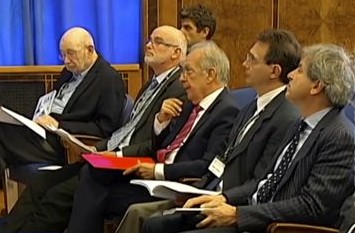
[Image above] Several ACerS members attended the recent Serbian Ceramic Society conference in Belgrade. From left: Sheldon Wiederhorn, NIST; ACerS president-nominee William Lee, Imperial College, London; Ninoslav Stojadinovic, SASA, vice president of Parliment, Republic of Serbia (not an ACerS member); and Paolo Colombo, University of Padova, Italy. Credit: PTC Media via V. Mitic
President of the Serbian Ceramic Society and American Ceramic Society member, Vojislav Mitic, reports that the recent Advanced Ceramic and Applications Conference III (ACA III) was a resounding success. More than 120 scientists and artists attended the conference in Belgrade, Serbia, Sept. 29–Oct. 1, 2014. Mitic says attendees came from Serbia, Romania, Japan, Canada, United Kingdom, Germany, France, Brazil, Bulgaria, Slovenia, Poland, and more. ACA III attendees included researchers, engineers, academy staff, and PhD students who presented their key advanced materials research, processing, characterization, and innovation activities. ACerS president-elect nominee, William Lee of Imperial College, London, was an invited plenary speaker.
Mitic says via email, “Advanced ceramics play an important role in the European Union’s prioritized materials to enable the transition towards to knowledge-based, low-carbon, cost-competitive and efficient societies.”
“The chosen conference topics open new frontiers in designing advanced ceramic materials since they cover fundamental theoretical research, modeling and simulation, controlled nanostructured materials synthesis, and optimization of the consolidation process. Together, these topics should provide practical realization of new ideas towards device miniaturization, energy-materials-information integration, and preservation of cultural heritage,” he says.
The program bears witness to the ambition of organizers for this conference with presentations on topics such as tailoring ceramic nanostructures for nanodevices, precision electrical discharge machining, ozone decay of oxides, ultrasonic processing of nanostructured functional titania, and more. Conference organizers included talks that bridge the gap between culture and science with two talks of general interest: “Where is archaeology without physical and chemical analysis in the ceramic technology studies?” and “Sculptural concretes: Use in restoration.”

Thermo Scientific representatives at the recent Serbian Ceramic Society conference expo. Credit: V. Mitic
The conference included a poster session for graduate students to present their work and a small exhibition from vendors of scientific instruments.
The Serbian Ceramic Society organized the conference in cooperation with the Institute of Technical Sciences of the Serbian Academy of Sciences and Arts (SASA), and the Institute of Chemistry Technology and Metallurgy, Institute of Physics, Institute for Technology of Nuclear and Other Raw Mineral Materials, Institute for Testing of Materials, and Archeological Institute of SASA.
